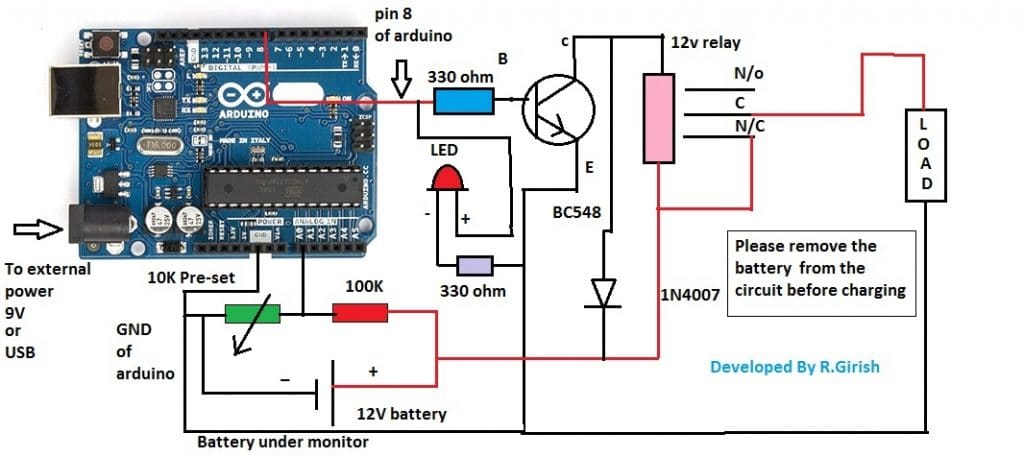In this post, I will show how to construct a over discharge protection circuit for 12v battery using Arduino which can protect 12V SLA battery against over discharge, and also protect the connected load from over voltage in case of overcharged battery is connected.
Understanding Battery Charge/Discharge Rates
All the batteries have natural decline, but most of them get damaged due to ignorance from the users part. The life span of battery will get shorten if the voltage of a battery goes below certain degree, in case of 12V SLA battery, it must not go below 11.80 V.
This project could be accomplished with comparators, but here we are using microcontroller and coding to accomplish the same.
This circuit is well suitable for resistive loads and other loads which don’t generate noise in the supply during operation. Try to avoid inductive loads such as brushed DC motors.
Microcontrollers are sensitive to noise and this setup may read error voltage values in such case, and it may cut-off the battery from load at wrong voltage.
How it Works


The discussed over discharge protection circuit for 12v battery consists of a voltage divider which is responsible for stepping down the input voltage and reduce to narrow range where arduino can read the voltage.
The 10k pre-set resistor is used to calibrate the readings on arduino; these readings are used by arduino to trigger the relay, the calibration of this setup will be discussed later part of the article.
A LED indicator is utilized for indicating the status of the relay. The transistor drives the relay on/off and a diode is connected across the relay for arresting high voltage spike generated from relay, while switching it on/off.
When the battery voltage goes below 11.80V, the relay gets turned on and disconnects the battery from load and LED indicator also turns on, this happen same when the circuit reads overvoltage from the battery, you can set the overvoltage cut-off in the program.
When the battery goes below 11.80V, the relay disconnect the load, the relay will reconnect the load to battery only after when the battery voltage attains above nominal voltage which is set in the program.
The nominal voltage is normal operating voltage of the load. The above stated mechanism is done because; the battery voltage rise after disconnecting from load and this must not trigger the relay ON at low battery state.
The nominal voltage in the program set as 12.70 V which is full battery voltage of typical 12V SLA batteries (Full battery voltage after disconnecting from charger).
Program Code:
//---------Program developed by R.Girish----------//
float cutoff = 11.80; //Cutoff voltage
float nominal = 12.70; //Nomial Voltage
float overvoltage = 14.00; //Overvoltage
int analogInput = 0;
int out = 8;
float vout = 0.0;
float vin = 0.0;
float R1 = 100000;
float R2 = 10000;
int value = 0;
int off=13;
void setup()
{
pinMode(analogInput,INPUT);
pinMode(out,OUTPUT);
pinMode(off,OUTPUT);
digitalWrite(off,LOW);
Serial.begin(9600);
}
void loop()
{
value = analogRead(analogInput);
vout = (value * 5.0) / 1024;
vin = vout / (R2/(R1+R2));
if (vin<0.10)
{
vin=0.0;
}
if(vin<=cutoff)
{
digitalWrite(out,HIGH);
}
if(vin>=nominal && vin<=overvoltage && vin>cutoff)
{
digitalWrite(out,LOW);
}
if(vin>=overvoltage)
{
digitalWrite(out,HIGH );
delay(10000);
}
Serial.println("INPUT V= ");
Serial.println(vin);
delay(1000);
}
//---------Program developed by R.Girish----------//
Note:
float cutoff = 11.80; //Cutoff voltage
float nominal = 12.70; //Nomial Voltage
float overvoltage = 14.00; //Overvoltage
You can change the cut-off, nominal and overvoltage by changing the above values.
It is recommended not modify these values unless you are working with different battery voltage.
How to calibrate:
The calibration for this battery over discharge protection circuit must be done carefully; you need a variable power supply, a good multimeter and a screw driver for adjusting the pre-set resistor.
1) The completed setup is connected to variable power supply without load.
2) Set the 13 volt on the variable power supply, verify this using multimeter.
3) Open the serial monitor and rotate the 10k preset resistor clock or counter clock wise and bring the readings close to the readings of multimeter.
4) Now, reduce the voltage of variable power supply to 12V, the multimeter and serial monitor must read same or very close value.
5) Now, reduce the voltage to 11.80 V the relay must trigger on and LED must light up.
6) Now, increase the voltage to 14.00V the relay must trigger on and LED light up.
7) If the above sets are successful replace the variable power supply with a fully charged battery, the readings on serial monitor and multimeter must be same or very close to same.
8) Now connect the load, the readings on both must remain same and synchronized.
If the above steps are successful your circuit is ready to serve the battery.
NOTE:
Please note this point while calibrating.
When the relay is triggered on due to low voltage cut-off or due over voltage cut-off, the readings on serial monitor will not read the correct voltage as on multimeter, and shows higher or lower than on multimeter.
But, when the voltage falls back to normal operating voltage the relay will turns off and starts showing correct voltage.
The conclusion of the above point is that, when the relay is trigged ON, the readings on the serial monitor show some significant variation and you need not to calibrate again at this stage.